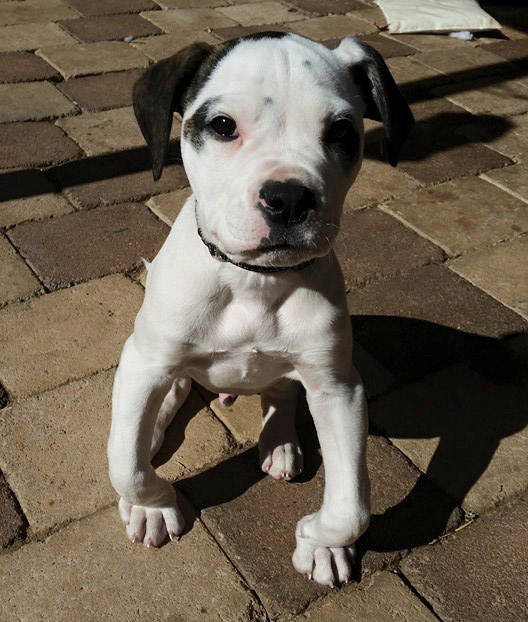If you’ve got a Great Dane puppy with legs that are bumpy or bowed out, or even just little paws that look at all crooked, then you likely want to fix this.
This problem, which is Carpal Laxity Syndrome, is often just called knuckling and it is one of those things that Great Dane owners should expect.
How bad knuckling is in a Great Dane varies from one dog to the next, and it can be quite upsetting to look at if you’re not prepared for it.
Sadly, no one knows definitively what causes knuckling in Great Danes, but there are some pretty good guesses out there.
Things like poor nutrition, stress, and hard floors are some of things that people think cause Carpal Laxity Syndrome, and below we’ll go over this in more detail.
We’ll also give you some tips on how to go about preventing and fixing knuckling in Great Danes.
What Causes Knuckling In Great Danes?
Since we have no definitive cause, other Great Dane owners and vets have combined their experience and knowledge to come up with a list of the things that seem mostly like to cause knuckling.
Nutrition and Diet
The most likely cause of Carpal Laxity Syndrome seems to be related to what your Great Dane is eating.
A poor nutrition and diet are most common amongst the puppies that exhibit knuckling, which seems to be truth for most of the bone growth disorders in large dog breeds.
Here are the poor nutrition and diet actions that may cause knuckling:
- Mixing different types of kibble
- Feeding your dog kibble that is not properly formulated
- Not consistently feeding your dog the same kibble
- Making your own dog food for your pup, including rice and chicken
- Feeding your dog entirely a raw food diet
- Putting multivitamins or supplements in your dog’s food
- Feeding your dog too much food at mealtime
- Not feeding your dog the right balance of phosphorus and calcium
We recommend: Eukanuba Puppy Large Breed Dry Dog Food for Great Dane puppies.
Environmental Causes
In addition to what your dog is eating, there are some environmental factors thought to cause knuckling in Great Danes.
These factors include:
- Hard, or slick, floors at home
- Nail not properly maintained
- Stress of any kind (travel, medical, etc.)
Signs Your Dog Is Developing Carpal Laxity Syndrome
If you are worried about knuckling appearing in your pup’s feet, then do know that there are some signs you can watch out for.
Here are the signs your puppy is developing knuckling:
- Legs are bowed out
- Ankles seem to position themselves over the top of the foot
- Legs seem weak because they shake even on carpet and other soft materials
- Splayed feet
- Front legs and feet look crooked (also known as ballerina feet)
Preventing Fixing Knuckling In Great Danes
Now that you know the things that are thought to cause the knuckling issues, let’s look at how you can prevent it and fix it.
The most important thing is here focusing on proper nutrition for the Great Dane.
Nutrition and Diet
When choosing what to feed your Great Dane puppy, try to avoid kibble that is listed as grain-free and anything with fat early in the ingredients list.
Instead, option for something with meat as a primary ingredient.
Pick one brand and one type of dog food and stick with it.
Ideally you want to adhere to the following for your Great Dane puppy’s diet:
- Protein: under 28%
- Calcium: ≥ 1.5%
- Fat: no more than 18% and no less than 12%
- Phosphorus: ≥ 1.5%
We recommend: Eukanuba Puppy Large Breed Dry Dog Food for Great Dane puppies.
You should also consider adding Vitamin C supplements to your dog’s diet.
Many Great Dane owners dealing with knuckling swear by it.
We recommend American Health Ester-C with Citrus Bioflavonoids Capsules at Amazon.
Start with just a 500mg dose for your doggo.
Environmental Fixes
If you are not trimming your Great Dane’s nails every 5 – 10 days, then you need to start!
Avoid letting those nails get too long be regularly trimming them.
If your home has hard floors or slick surfaces, then put down rugs and runners to make the surface softer.
And avoid walking your dog on hard surfaces, like sidewalks and pavement, when possible.
Instead, opt for grassy areas for walks.
Make decisions that focus on positive orthopedic development for your dog, such as limiting crate time
And consider a canine orthopedic bed for your Great Dane, like the Big Barker.
Final Word
While noticing knuckling in your Great Dane puppy can be worrying, the good news is that there are steps you can take to fix this problem.
And if your dog doesn’t yet have this issue, then you can just follow our tips above to prevent knuckling in your Great Dane puppy.
Keep in mind that you should also check in with your dog’s vet for advice on this problem.




